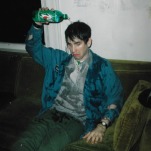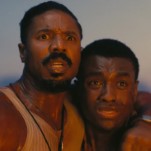Exclusive: Tongues Cartoonist Anders Nilsen Offers Sketch Commentary on his Mythical, Bold Graphic Novel

Anders Nilsen’s work carefully evades description. His marquee 658-page graphic novel, Big Questions, united bombs, planes and birds in an enigmatic stream-of-conscious masterwork that we’re still unpacking. But the Portland-based artist’s mark is unmistakable; elaborate panels that spit in the face of conventional rectangles, designs that segue between the organic and mechanical, and shifting patterns that wind and ebb into the molecular. Nilsen writes excellent dialogue and characterization, but his output feels like pure subconscious melody devoid of superego interference. And this makes sense—in an interview with Hillary Brown for his mesmerizing sketchbook, Poetry Is Useless, Nilsen explained that, “The more thought that goes into [my comics] the worse they come out, probably. The best ones unfold intuitively. And usually I am playing with a certain constellation of shapes and associations, which changes a bit over time. Symmetry is usually more compelling when it is broken in some subtle way.”
In his new project Tongues, the comic appropriately opens in a primordial dream, the cosmic fugue state that seems to course through Nilsen’s oeuvre. Without wandering into spoiler territory, the narrative involves a deity chained to a mountainside in Central Asia, a backpacking wanderer making a cameo from a previous book and an East African orphan set on a Joseph Campbell quest. Nilsen sought inspiration from the Greek yarn of Prometheus and the plays of Aeschylus, but these achingly big, nuanced vistas drown into a surreality all their own. Tongues is being self-published into serialized collections, with Pantheon Books compiling the affair in one hardback upon completion.
The first collection of Tongues releases later this month, and Nilsen was kind enough to provide commentary on the sketches that led to the book’s creation.
![]()

“I had to learn a bunch of new stuff for this book. One thing was how to convincingly draw a monkey, which seems like it should be easy, but isn’t. What I arrived at with the assistance of Google Images search, was a sort of cross between a spider monkey and a capuchin.”![]()

“These two characters are from a sequence I drew several years ago. Once upon a time I was asked to turn my book Dogs and Water into a screenplay (nothing ever came of this in case anyone’s wondering). To fill the story out to feature length, I had to add some scenes. These two characters, and the scene they appear in in the book, came out of that screenplay and were one of two or three little stray ideas that slowly came together over time and accreted into Tongues. Some ideas are very insistent in wanting to come to life, not just sit in a sketchbook on a shelf, or filed away in a hard drive.”![]()

“I did more preparatory sketches of this character, Astrid (AH-stree) than any other in the book. It felt very important to get her affect and particular look just right. I have a bunch more versions in other notebooks.”![]()

“Sketches of typography for the title. As is often the case, simpler is better, and the actual examples I used are various letters from lines four and five on this page—the O, N, G and S from “songs” and the extra T, U and E from below that. This notebook is filled with examples and attempts of trying to get the type just right and usually overdoing it.”![]()

“A working sketch of the final cover.” ![]()
-

-

-

-

-

-

-

-

-

-

-

-

-

-

-

-

-

-

-

-

-

-

-

-

-

-

-

-

-

-

-

-

-

-

-

-

-

-

-

-



















































